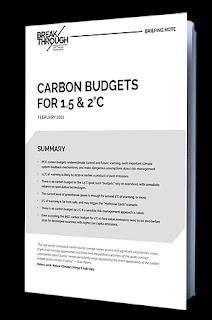Zero by 2050 or 2030? 1.5°C or 2°C? Overshoot or not? Demystifying carbon budgets.
Confused about carbon budgets for the Paris climate goals? Zero by 2050 or 2030? 1.5°C or 2°C? Overshoot or not?
There is a maze of contradictory positions, claiming to be based on research evidence. But the assumptions behind much of that evidence obscures some startling conclusions.
The Breakthough Briefing Note on “Carbon budgets for 1.5 & 2°C”, released today, explores some of the myths and realities about the Paris Agreement targets and the associated carbon budgets, and what it would really take to achieve them.
The main findings are:
- IPCC carbon budgets underestimate current and future warming, omit important climate system feedback mechanisms, and make dangerous assumptions about risk-management.
- 1.5°C of warming is likely by 2030 or earlier, a product of past emissions.
- There is no carbon budget for the 1.5°C goal; such “budgets” rely on overshoot, with unrealistic reliance on speculative technologies.
- The current level of greenhouse gases is enough for around 2°C of warming, or more.
- 2°C of warming is far from safe, and may trigger the “Hothouse Earth” scenario.
- There is no carbon budget for 2°C if a sensible risk-management approach is taken.
- Even accepting the IPCC carbon budget for 2°C at face value, emissions need to be zero before 2030 for developed countries with higher per capita emissions.
And it’s not that this blog has been avoiding the issue of carbon budgets. Far from it! Our posts since 2009 include:
- Forget about 2050, we’re blowing the carbon budget right now (2009)
- A new reality check on the global carbon emissions budget (2009)
- Commission’s call for carbon budget beyond political belief (2011)
- Confused about the new IPCC’s carbon budget? So am I. (2013)
- Carbon budgets, climate sensitivity and the myth of “burnable carbon” (2014)
- The real budgetary emergency and the myth of “burnable carbon” (2014)
- No carbon budget left to burn (2014)
…click on the above link to read the rest of the article…
